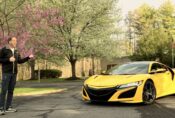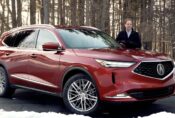2013 Acura RDX AWD Tech
Before you lament the loss of the turbo and Acura’s super-handling all-wheel drive system, consider this: the 2013 RDX delivers 33 more horsepower, comes in weighing almost 100 pounds lighter, offers more passenger and cargo room, gets an extra gear for its automatic transmission and achieves highway fuel economy that’s almost 20% better than before. In other words, the RDX has redefined itself as more mainstream and refined while increasing its overall appeal. And though it’s not the kind of small, premium SUV that’s going to grab headlines for its razzle-dazzle characteristics, it is the kind that owners will fall in love with. How do you define that special connection an owner makes with his vehicle? When it comes to a utility vehicle, it really boils down to 2 attributes: it’s got to make life easier and it has to be masterful at a wide range of tasks. And the RDX gives you both. Smart key access with push button start, an agreeable step-in height, living-room comfortable seats and excellent visibility make the first impression. Theater-style rear seats with increased leg room, easy-fold seats to expand increased cargo room and a power tailgate meet all of the prerequisites of everyday utility. And as it pertains to the drive…(stand-up)
The 273-horsepower 3.5-liter V6 isn’t a modern marvel, but it is very powerful and smooth in its operation – a perfect match for the new 6-speed auto with sport mode and paddle shifters. This combo sets the benchmark for expertly tuned fineness. And though the turbo generated more torque, the 251 pound feet flexed here is matched with more aggressive gearing to produce lively acceleration and excellent flexibility. Benefiting from variable cylinder management, gas mileage for this RDX AWD is rated at 19mpg city/27mpg highway, unfortunately on 91-octane. The gas tank is also smaller but a cruising range of 317 miles is still greater. The redesigned chassis matches new electric steering, better dampers and improved brakes combining to further elevate the superior drivability of the RDX. Torque-vectoring all-wheel drive, which has the added benefit of improving dry-road handling, has been replaced with a more conventional system that apportions power to the rear wheels based on specific road conditions to minimize front wheelspin.
My tester is the top-of the line RDX AWD with tech package stickering for $40,315. I’ve never been a huge fan of Acura’s technology layout as its controls and usage are a bit cumbersome but the package adds a host of items I wouldn’t want to be without including navigation, surround sound, dual zone climate control, HID headlights, fog lights and the power tailgate. Acura’s tagline is Advance and consumers view the brand as tech savvy but I see only slight evidence of that with the RDX. Though the cabin is largely user friendly, quiet and comforting, Acura seems to be following rather than advancing the modern car experience. In that regard, the RDX is a bit disappointing. From its more conservative design to its industry defying removal of the turbo, Acura has exchanged some excitement for reasonable improvements leading to a better vehicle that stands-out for its solid execution.

 ACURA NSX 2020 TEST DRIVE
ACURA NSX 2020 TEST DRIVE 2022 ACURA MDX TEST DRIVE
2022 ACURA MDX TEST DRIVE 2021 Acura TLX A-Spec TEST DRIVE
2021 Acura TLX A-Spec TEST DRIVE